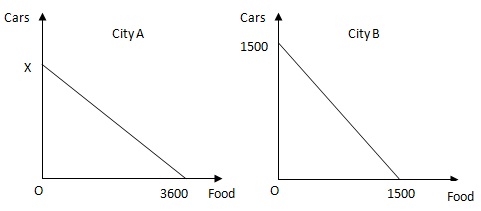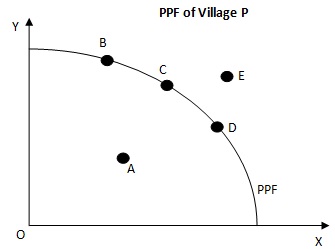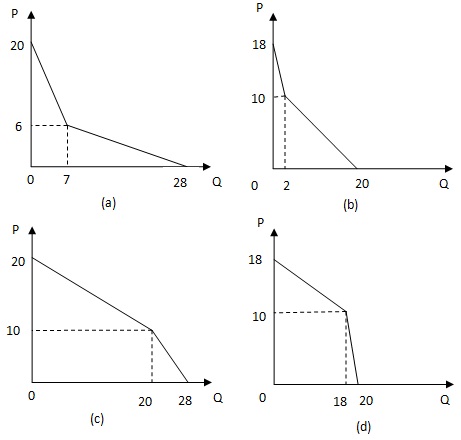I. Binary Choice Questions (10 questions)
Question 1. Elizabeth has eaten more pineapple cakes for free at school this month. Her mom tells her that pineapple prices in the grocery stores have risen compared to last month’s prices. Such a scenario of free cakes but higher consumer prices occurs when the government implements an agricultural farm _______ program.
a. Price support
b. Price subsidy
Question 2. The cost of producing beer increased by $1.50 per bottle. Holding everything else constant, the equilibrium quantity of beer decreases. The change in the quantity demanded is due to _______.
a. A movement along the demand curve.
b. A shift in the demand curve.
Question 3. Suppose the initial market demand curve for potatoes is given by the equation:
2Qd = 5 - 2P
Now, suppose income for the individuals in the potato market increases, and the new market demand curve for potatoes can be written as:
Qd = 2 - P
From this information we know that potatoes are
a. A normal good.
b. An inferior good.
Question 4. Point (3, 6) and point (6, 3) lie on line A. Line A must be upward sloping.
a. True
b. False
Question 5. Consider the statement: “The US Government has an obligation to provide an overall health insurance plan covering all of its citizens.”
a. This is a normative statement.
b. This is a positive statement.
Question 6. Assume that the Kindle and the iPad are substitute goods. If the price of the iPad decreases, then the price of the Kindle will holding everything else constant.
a. Decrease
b. Increase
The PPF of two cities are given in the following figure. Both cities produce only two goods: food and cars. Use the figure to answer the next two questions.

Question 7. Suppose X = 1800. City A is currently producing 1600 units of food and 900 cars.
a. City A is producing efficiently.
b. City A is producing inefficiently.
Question 8. Suppose X = 1800. City A has both an absolute and a comparative advantage in the production of cars.
a. True
b. False
Question 9. Suppose we have an upward sloping supply curve and a downward sloping demand curve in the market for cigarettes. Suppose that relative to the initial equilibrium situation that the number of smokers decreases while at the same time some of the cigarette producers are shutdown due to their failure to meet environmental standards. What is the effect of these two events on the equilibrium price and quantity in the market for cigarettes?
a. The new equilibrium price may increase, decrease or remain the same and the equilibrium quantity decreases.
b. The equilibrium price decreases and the equilibrium quantity may increase, decrease or remain the same.
Question 10. Total producer surplus is defined as the sum of
a. The sum of the gains to individual producers from selling a good minus the opportunity costs of producing the good.
b. The dollar value of all the sellers' willingness to sell a good plus the price of the good.
II. Multiple Choice Questions (26 questions)
Question 11. Which of the following statements is true?
a. Coffee and cream are complements. Holding everything else constant, when the price of coffee increases, the demand for cream increases.
b. Coffee and cream are complements. Holding everything else constant, when the price of coffee decreases, the demand for cream increases.
c. Coke and tea are substitutes. Holding everything else constant, when the price of coke decreases, the demand for tea increases.
d. Coke and tea are substitutes. Holding everything else constant, when the price of coke increases, the demand for tea decreases.
Question 12. A price floor set below the market equilibrium price creates ________ in that market.
a. a surplus
b. a shortage
c. no change
d. a demand shift
Question 13. Suppose we have a straight line A. Shifting line A to the right along the horizontal axis by 3 units gives us line B which can be written in slope-intercept form as Y = 3X – 3. The slope-intercept form of line A is therefore
a. Y = 3X + 6
b. Y = 3X + 9
c. Y = 3X - 6
d. Y = 3X - 12
Question 14. Nelson is considering watching a Badger’s football game. He has to pay $50 for a ticket. If not watching football, Nelson can work as a programmer at the university computer lab and earn $40. Nelson’s opportunity cost of watching the football game is _____.
a. $10
b. $40
c. $50
d. $90
Question 15. Consider the wooden table market. Suppose that the price of wooden chairs increases and simultaneously the price of wood decreases. The equilibrium price for wooden tables will ____ and the equilibrium quantity will ________.
a. fall, not be determined
b. rise, not be determined
c. not be determined, rise
d. not be determined, fall
Use the following graph to answer the following question:

Question 16. The Production Possibility Frontier (PPF) of Village P is given in the above graph. Which of the following statements is true?
a. Resources are fully employed at point A.
b. From point D to point B along the PPF curve, the opportunity cost of producing good Y increases.
c. Point B and Point D are more efficient than point C.
d. Point E is feasible but inefficient.
Use the following information for the next two questions.
Let the apple market demand be QD = 5 - 0.5P
Let the apple market supply be Qs = 2P.
Question 17. Find the equilibrium price (P) and quantity (Q).
a. P=4, Q=4
b. P=2, Q=2
c. P=4, Q=2
d. P=2, Q=4
Question 18. If the price is not determined by market forces but is simply set at $1.00, then
a. There will be a shortage of 2.5 apples in the market.
b. There will be an excess supply of 2.5 apples in the market.
c. There will be a shortage of 5 apples in the market.
d. There will be an excess supply of 5 apples in the market.
Question 19. Holding everything else constant, if the price of a product decreases, we would expect
a. the demand curve for that product to decrease.
b. the quantity supplied of that product to increase.
c. the supply curve of that product to increase.
d. the quantity demanded of that product to increase.
Use the following information to answer the next three questions:
The table below shows what China, France and US can produce per week if they specialize and use all of their resources to produce a single good. Assume that each country’s PPF is linear.

Question 20. Which country has the comparative advantage in producing computers? Which country has the comparative advantage in producing Airplanes?
a. China, France
b. China, US
c. US, US
d. US, France
Question 21. Suppose China proposes that it will trade 20 computers for an airplane. Which country or countries will accept this price and trade with China?
a. Only France
b. Only US
c. Both France and US
d. Neither France nor US
Question 22. Suppose the US proposes that it will trade one airplane for 20 computers. Which country or countries will accept this price and trade with the US?
a. Only China
b. Only France
c. Both China and France
d. Neither China nor France
Use the following information to answer the next two questions:
Suppose you observe that the market for sandwiches behaves as follows: If the price of sandwich is $2, the total quantity demanded is 26. When the price goes up to $3, the total quantity of sandwiches demanded is 24. On the supply side, when the price of a sandwich is $0, the total quantity supplied is 0. When the price of a sandwich jumps to $10, the total quantity of sandwiches supplied is 40. Assume both the demand and the supply curves for sandwiches are straight lines.
Question 23. What is the equilibrium price and quantity in the market for sandwiches?
a. P = 4, Q = 16
b. P = 5, Q = 20
c. P = 4, Q = 22
d. P = 5, Q = 16
Question 24. Suppose the government imposes a price ceiling of $4 in the market for sandwiches. What will be the effect of this price ceiling in this market?
a. There will be a shortage of 4 sandwiches.
b. There will be a shortage of 6 sandwiches.
c. There will be a shortage of 8 sandwiches.
d. There will be no shortage.
Use the following information to answer the next three questions:
Let the market demand curve for soybeans be P = 16 – 2Q.
Let the market supply curve for soybeans be P = 1 + Q.
Question 25. Now suppose the government sets a price floor in the market for soybeans at a price of $8 per pound. Find the quantities demanded and supplied at the new price floor of $8.
a. Quantity demanded = 0, Quantity supplied = 9
b. Quantity demanded = 8, Quantity supplied = 7
c. Quantity demanded = 4, Quantity supplied = 7
d. Quantity demanded = 5, Quantity supplied = 5
Question 26. As a result of the imposition of the price floor described in the previous question, the government decides to purchase the excess supply. Assume that the storage costs for each pound of soybeans is $2. Calculate the total cost (including storage costs) of the price floor program to the government.
a. $6
b. $18
c. $24
d. $30
Question 27. Suppose the government guarantees suppliers of soybeans a price of $8 per pound of soybeans. The government decides to offer a subsidy to soybean producers rather than implementing a price floor. How much subsidy does the government have to offer for each pound of soybeans when it implements this program?
a. $2 per pound of soybeans
b. $4 per pound of soybeans
c. $6 per pound of soybeans
d. $8 per pound of soybeans
Question 28. If Mary can produce muffins at a lower opportunity cost than Daniel, then
a. Daniel has a comparative advantage in the production of muffins.
b. Daniel does not have the absolute advantage in the production of muffins.
c. Mary has a comparative advantage in the production of muffins
d. It is obvious that Mary is capable of producing more muffins than Daniel.
Use the following information to answer the next four questions:
Suppose the market for strawberries is composed of two consumers: Arik and Junjie. Arik’s demand for strawberries is given by QA = 18 – 3P, and Junjie’s demand for strawberries is given by QJ = 10 – (1/2)P.
Question 29. Which of the following pictures describes the market demand curve for the strawberry market?

Question 30. Suppose the equilibrium price for strawberries is P = 4, how many strawberries will Arik and Junjie buy respectively?
a. Arik 4, Junjie 10
b. Arik 8, Junjie 6
c. Arik 12, Junjie 12
d. Arik 6, Junjie 8
Question 31. Suppose the market supply curve in the strawberry market is given by P = (4/3)Q. What will be the equilibrium price and quantity in this market given the above information about Arik and Junjie’s demand for strawberries?
a. P = 6, Q = 7
b. P = 8, Q = 6
c. P = 10, Q = 5
d. P = 4, Q = 14
Question 32. What will be Arik and Junjie’s consumer surplus respectively equal when the strawberry market is in equilibrium?
a. Arik $8, Junjie $10
b. Arik $6, Junjie $20
c. Arik $0, Junjie $36
d. Arik $10, Junjie $18
Use the following information to answer the next three questions:
Consider the city of Madison.
Let the demand for bread be described by P = 10 - QD
Let the supply of bread be described by P = 2 + QS
Question 33. Find the market equilibrium
a. Price=$3, Quantity=5
b. Price=$4, Quantity=6
c. Price=$6, Quantity=8
d. Price=$6, Quantity=4
Question 34. The city of Madison sets a price ceiling of $3 in the bread market. Is there a surplus or a shortage in the bread market after the imposition of the price ceiling? How much?
a. Surplus, 2 units of bread
b. Surplus, 6 units of bread.
c. Shortage, 2 units of bread.
d. Shortage, 6 units of bread.
Question 35. What would the price ceiling level have to be for the quantity supplied of bread to be equal to 3 units?
a. $2.
b. $3.
c. $4.
d. $5.
Question 36. Consider the market for bicycles in Madison and assume riding bicycles and riding the bus are substitutes. Due to a shortage of aluminum, an input for bicycle production, the price of aluminum increases. At the same time, Madison Metro Bus Company raises bus fares for all bus rides. What will happen to the equilibrium price and quantity in the bicycle market, holding everything else constant?
a. Quantity will decrease, and price will increase.
b. Quantity will increase, and price will decrease.
c. Quantity will decrease, and the effect on price is indeterminate.
d. Price will increase, and the effect on quantity is indeterminate.